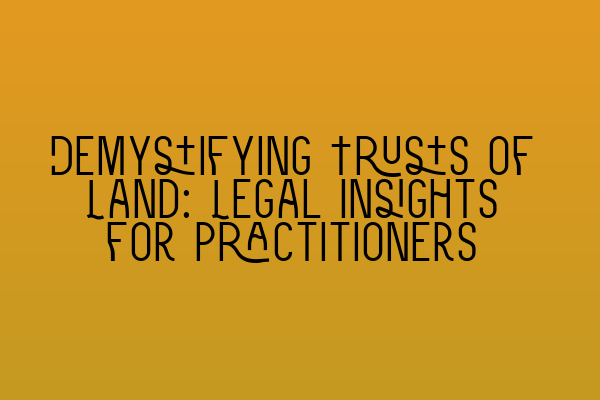Demystifying Trusts of Land: Legal Insights for Practitioners
Trusts of land play a crucial role in property law and are a common occurrence in real estate transactions. As a practitioner in property law, it is essential to have a comprehensive understanding of trusts of land to effectively advise your clients and navigate the intricacies of such arrangements.
In this article, we aim to demystify trusts of land by providing legal insights and guiding practitioners through the fundamentals, key considerations, and best practices. Whether you are a seasoned professional or a newcomer to property law, this article will equip you with the knowledge you need to confidently handle trusts of land cases.
The Basics: What Are Trusts of Land?
Trusts of land, as the name suggests, involve legal arrangements where the ownership of property is split between legal and beneficial interests. In simple terms, trusts of land refer to situations where one person owns property but holds it on behalf of another person.
These arrangements commonly arise in various scenarios, such as family homes, jointly owned properties, investment properties, and development projects. Understanding the different types of trusts of land and the legal principles that govern them is vital for any property law practitioner.
Different Types of Trusts of Land:
1. Bare Trusts: A bare trust is the simplest form of trust. It occurs when the legal owner holds the property for the benefit of the beneficiary, with no obligations or responsibilities attached. The beneficiary has an absolute right to the property and can request transfer or sale at any time.
2. Implied Trusts: Implied trusts are not explicitly stated in writing but arise from the actions and conduct of the parties involved. These trusts are often based on the understanding or common intention of the parties.
3. Constructive Trusts: Constructive trusts arise when a person, through their actions or contribution, acquires an equitable interest in the property even though they may not have legal ownership. These trusts are often found in cases of unjust enrichment or where one party has been misled or deceived.
4. Resulting Trusts: Resulting trusts occur when a property is purchased in the name of one person, but the intention is for another person to have beneficial ownership. These trusts arise from the presumption that the person who provided the purchase money intended to retain a beneficial interest.
Key Considerations in Trusts of Land:
1. Formation: Trusts of land can be created formally through written agreements or informally through oral agreements or conduct. Understanding the requirements for the valid creation of a trust is crucial to ensure the enforceability of the arrangement.
2. Legal and Beneficial Interests: Recognizing the distinction between legal and beneficial ownership is essential in determining the rights and responsibilities associated with trusts of land. Legal owners hold the property’s legal title, while beneficiaries have the equitable interest.
3. Trustees’ Duties: Trustees have fiduciary duties towards the beneficiaries, including the duty to act in their best interests, exercise reasonable skill and care, and avoid conflicts of interest. Practitioners must guide their clients on their obligations and advocate for compliance with these duties.
4. Dispute Resolution: Disputes relating to trusts of land can arise from various factors, such as disagreements over the property’s management, sale, or division. Awareness of dispute resolution mechanisms, such as mediation or litigation, is crucial for practitioners to effectively support their clients and find amicable solutions.
Best Practices for Practitioners:
1. Thorough Due Diligence: Conducting comprehensive due diligence is imperative when dealing with trusts of land. This includes investigating the history of the property, determining the valid creation of the trust, and ensuring compliance with any legal requirements or restrictions.
2. Clear Documentation: Drafting clear and concise documentation is vital in avoiding misunderstandings and disputes down the line. Clearly setting out the parties’ intentions, the property’s ownership structure, and any associated rights or obligations will provide a solid foundation for the trust’s operation.
3. Regular Communication: Maintaining regular communication with clients and beneficiaries is crucial to stay updated on any changes in circumstances or potential issues. This will allow practitioners to provide timely advice and take appropriate action to protect their clients’ interests.
4. Ongoing Review: Regularly reviewing trusts of land and keeping accurate records is essential to ensure compliance with legal requirements and adapt to changing circumstances. Practitioners should advise their clients to periodically review their trusts and seek legal advice when necessary.
As a property law practitioner, staying up to date with the latest developments, case law, and best practices is paramount to provide effective representation to your clients.
If you are preparing for the SQE exam or are interested in enhancing your legal knowledge, check out our related articles:
– SQE 1 Practice Exam Questions
– SQE 1 Practice Mocks FLK1 FLK2
By continuously expanding your knowledge and skills, you can confidently tackle any trusts of land case and provide invaluable legal advice to your clients.
